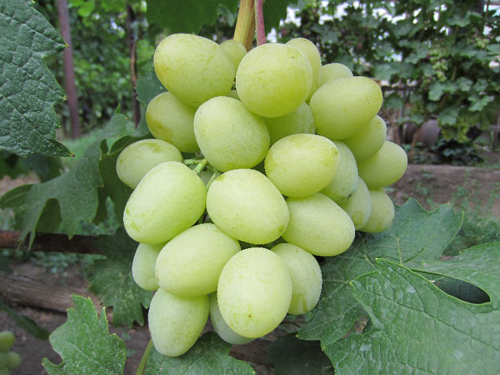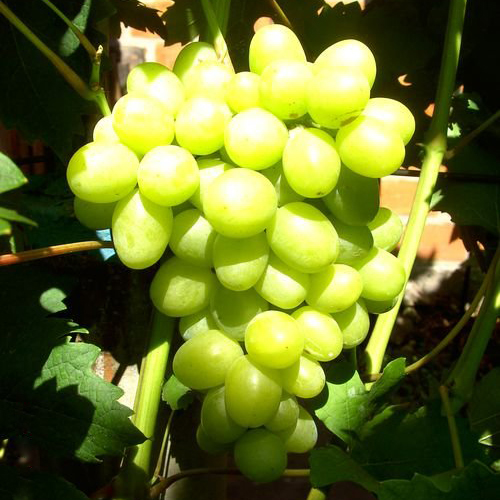Darya grape variety
The hybrid form of Daria grapes is a large-fruited, light-colored table variety that was born at the end of the 2000s. Its author is the famous domestic national breeder Viktor Krainov, who, in addition to our heroine, has dozens of excellent varieties and hybrids, many of which have passed the state test and official registration in the State Register of Breeding Achievements of the Russian Federation. In this case, excellent parental forms were used for crossing - Kesha, selection of the Novocherkassk Scientific Research Institute of Viticulture and Winemaking named after ME AND. Potapenko and friendship, an excellent Russian-Bulgarian variety in its characteristics.

To understand how responsibly Viktor Nikolaevich approached the selection of his offspring, it is worth noting that Daria's seedling was initially rejected by the researcher, and at the request of one of his comrades was presented to him. The form began to give the first full-fledged harvests after the author passed away, and then began to spread among winegrowers. Farmers and ordinary amateurs are impressed by the size of the bunches and berries of the variety, its early ripening period, high yield and pleasant nutmeg aroma of the fruit. Its negative features are considered to be a slightly greenish color of the skin of grapes, which persists even when ripe, as well as insufficiently high frost resistance, which requires almost universal shelter of bushes for the winter.
But, be that as it may, over the years the hybrid has gained a circle of its loyal fans, and in terms of the totality of characteristics it looks more than worthy.
It should also be noted that in addition to Daria, in the widest ampelographic variety there are varieties with similar names, for example, Dashenka and Dashunya, but they have nothing to do with our heroine. This is important to know in order to avoid confusion when buying seedlings and subsequent disappointment when they enter fruiting.
Agrobiological properties
The vigor of the vines is high. The leaves are large, rounded, five-lobed, very beautifully cut. Both the upper and lower incisions are deep, often closed with an ovoid lumen, less often open in the form of a lyre with a rounded bottom, some are also found with parallel sides. The leaf surface is smooth, dark green, on which lighter veins are clearly outlined. The profile of the leaf blade is flat or slightly wavy. The petiole notch assumes various forms, from closed with a rounded lumen to open wide-vaulted. The petioles are long, reddish with varying degrees of intensity. The denticles along the perimeter of the leaf are of considerable size, as a rule, triangular with a wide base, straight or slightly curved edges, and pointed apices. The flowers are bisexual, the pollen has good fertility, due to which pollination is excellent, the berries are well tied, forming a perfectly executed bunch without signs of peas. Scattering of buds and ovaries was also not noticed. During the growing season, the one-year growth has time to mature sufficiently. In autumn, the vine acquires a yellowish brown color in the internodes and a darker color of the nodes.

Ripening brushes are very large, their weight often reaches one and a half kilograms, and the average weight is about 600 - 800 grams. The shape of the bunches is conical or broadly conical, the structure is moderately dense. Berries are not damaged or deformed against each other. The evenness of their caliber gives the brushes a special elegance and attractive appearance. The combs are long, herbaceous, but strong enough, light green with longitudinal stripes of anthocyanin tones. The grapes are massive, ovoid, with an average weight of 12-14 grams, some up to 20 grams.Outside, the berries are painted in a light milky or yellowish color with a greenish tinge, the skin is covered with small brown dots and a thin layer of whitish waxy coating. The flesh of the fruit is dense, juicy-fleshy, of an amazingly harmonious taste with a long persistent aftertaste due to the bright aroma of citron-type nutmeg. The juice is colorless, it is distinguished by high sugar content - about 19 - 20 g / 100 ml. There is no exact information on the content of titratable acids in juice, however, judging by the harmonious taste of berries, this parameter is within standard limits. The peel is medium in density and thickness, it chews well when eaten. Seeds are present, as a rule, two in a berry, but they do not carry a significant negative effect.
The harvested crop is mainly used for fresh consumption. Excellent appearance, taste and aroma of grapes leave no one indifferent. Farmers cultivating the hybrid form for commercial purposes note its unconditional "marketability". The only drawback in the implementation is the greenish color of the grapes, however, having tasted Daria and appreciated her delicious gastronomic characteristics, customers willingly purchase it, and the bunches do not stale on the shelves. A big advantage is that our heroine ripens relatively early and goes on sale during a period of high grape prices, providing its owners with sufficient profitability of cultivation. Unfortunately, the crop is not intended for long-distance transportation due to its average transportability, but it gets from the field to local markets without losing its excellent presentation at all. It is also not suitable for long-term storage, however, the use of refrigerating chambers or cellars with a low temperature allows you to avoid mass spoilage of berries within a month. If this is not possible, then the surplus of grapes may well be used in home canning. It will produce juices, compotes, preserves and marinades, excellent in every respect, fragrant with the incomparable aroma of nutmeg.

From the moment the eyes awaken in the spring, it takes about 105 - 115 days until the time when the bunches reach their removable ripeness, soften, accumulate sufficient sugar and reduce acidity. With such a growing season, Daria belongs to very early varieties, which require a very modest amount of active temperatures for the development and ripening of fruits, in the range of 2200 - 2400 ° C. This fact opens up the prospects for the cultivation of the form for winegrowers not only in the abundantly provided warm south, but also in the middle zone of the country, where not every grape variety has time to ripen.
Certain restrictions on the promotion of the hybrid north of the traditional viticultural zones are imposed by the not very high frost resistance of the vine, not exceeding −22 ... −23 ° С. However, the formation of plants according to squat, stumpless schemes and careful warming of the bushes for the winter, in the vast majority of cases, remove this problem. Covering cultivation is practiced by many owners of the variety, cultivating "sun berry" in the southern regions. Thus, they are reinsured against freezing of plants in case of abnormally cold winters for these places.
Daria's productivity reaches very high values due to her good fertility and the large size of the brushes. From each adult bush, you can consistently receive up to 20 kilograms of a high-quality crop, and the plants themselves strive to lay it much more, thereby creating the preconditions for their own overload. If you do not restrict such a tendency by strict rationing of the number of shoots and bunches, you can encounter all the "delights" of an outrageous load - a deterioration in the growth energy of the vine and its late ripening, lengthening of the growing season, crushing and a decrease in the palatability of fruits. To prevent this, during spring pruning, no more than 30 - 40 eyes are left on the bushes, with the length of the fruit arrows 6 - 8 buds. Be sure to carry out a fragment of sterile and weak shoots, and on fruit-bearing ones, remove excess inflorescences.
After ripening, the brushes can hang on the vine for a long time without cracking or rasping even in adverse weather conditions.The berries, as a rule, are not damaged by gray rot, and the hybrid has an average resistance to other fungal diseases. Several preventive treatments with systemic fungicides will be sufficient to control common pathogens.








